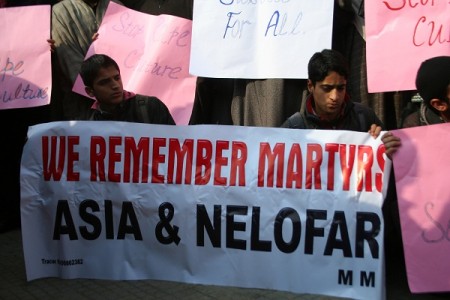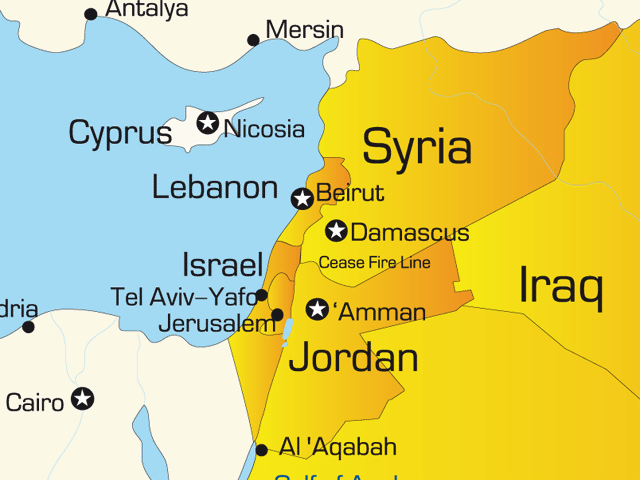
In the afternoon of 29th May, 2009 at Bongam, Shopian district of Indian Occupied Jammu and Kashmir, two young women left home for their orchard; and never returned.
Neelofar and Asiya were sisters-in-law. Neelofar was married to Asiya’s brother, Shakeel, and had an infant son. Asiya was a school-going teenager.
In the evening, Shakeel started searching for his sister and wife and later, at night, he sought the help of local police and together, they searched them throughout the countryside.
The local police stopped the search at midnight, promising to resume at early morning. Around 5:30 a.m., Shakeel started to search again. An hour later, the local police joined him and immediately, Neelofar’s body was found at a spot near Zavora Bridge, over the Rambi Ara Nallah. The depth of the stream around the spot was about 2.5 feet, with fast flowing water, but certainly not that strong a current that could drown an adult girl. (t was the very same spot which had been carefully searched by the family and police till 2:30 a.m.).
Asiya’s body was found further downstream from Zavora Bridge. Those who helped in retrieving their bodies saw enough to believe that this was a clear case of rape and murder, as the dead bodies showed visible signs of injuries and wounds.
Two post-mortems were performed on each one of them. Although the first post mortem report negated drowning as the cause of death of Asiya and Neelofer, yet, it was finally put out by the police that the deaths were caused by drowning.
Neelofar’s body was found in the very place where the police and family had looked for them the previous night; implying that it was not there at 2:30 a.m., but was found at about 6 o’clock. And no one admits to having seen it happen despite the high security in the area.
For the accidental drowning of two women, in such shallows as this nallah (brook) where no one had ever or would ever drown, one would need to be more than just naive to believe it possible!
Their dead bodies were buried after a controversial beginning to the criminal investigations at the end of May, 2009, following a great deal of public protests in Shopian against the police and district administration.
A trail of cover up was set by the police immediately after, which included a refusal to even file an FIR. The government appointed an Enquiry Commission, owing to the pressure by the people in Shopian.
The Commission too, concluded that the bodies could have been brought there by some agency, since no single individual could dare to execute such an act in a high security zone. It could not, however, find out who was responsible for the rapes and murders, since the police had not collected any evidence from the site.
That is the tragic reality of life in Jammu and Kashmir – two young women found dead, no convincing explanation for the deaths or for the inexplicable appearance of the bodies, at a spot which had been thoroughly searched just a couple of hours ago and is surrounded by the District Police Lines, an army outpost and a CRPF camp.
As predicted and to the utter disgust of Kashmiris, this Shopian incident of rape and murder was officially declared a case of ‘drowning’, and justice got buried somewhere in the files of government offices.
In cases of human rights abuse, and predominantly in cases of rape, there is not only a systematic refusal by the Indian government to ensure justice or set up an element of accountability among the security forces; rather, every effort is made to cover up such heinous crimes.
The Shopian incident symbolizes the injustices meted out to the people living in a highly militarized state. This sad incident not only marks the level of fear psychosis, as well as the denial of security and the basic rights to the people living in this region, but also reveals the utter refusal of those at the helm of affairs to bring the culprits of gross violations of human rights to justice.
The last two decades in Kashmir are marked by massive brutalities on the Kashmiri people at the hands of the Indian security forces. Till date, no culprits in uniform have been convicted or punished. Despite many accusations, with serious evidence, very few cases were ever investigated. In a minor number of cases, prosecution took place. And in none of them has justice ever been delivered.
The Shopian incident is not a case in isolation; it is a chapter out of a long history of human rights abuse, along with utter impunity that men in uniform enjoy in the state of Jammu and Kashmir. These men in uniform have been accused in thousands of cases of disappearances, molestations, sexual assaults, torture, humiliation, encounters and other forms of harassment. The state has a long list of the victims of such violence, none of whom has ever received justice.
Like every year, dozens of organizations in Kashmir assembled in solidarity all over the valley, seeking justice for Asiya and Neelofar, this year as well. A seminar entitled “Struggle for Justice” was held by the Majlis-e-Mushawarat Shopian, which had spearheaded the agitation following the double rape and murder of Neelofar and Asiya; while the little innocent 4 year old Suzanne, the adorable son of Neelofar, still waits for his mother and aunt, Asiya. His days and nights pass asking his dad Shakeel Ahangar, “Papa, Mama kab aayegi?” (When will Mom come back?)
Ah! You, the Human Rights Organisations of the world, can you bring his mother back? Ah! You, the so-called largest democracy, can you answer Suzanne’s innocent question?
Kashmir remembers its martyrs, its sisters who have been raped, its daughters who have been molested and brothers who have disappeared. The democratic thugs of India may forget this, but how can the oppressed Kashmiris; as they have only their martyrs, memories and scars? The shrieks and cries still echo in the green, lush fields of Shopian. The flowing waters of Rambi Ara Nallah are the memorial of this gruesome incident, reminding Kashmir of its Asiya and Neelofar.
You can hear the melancholic tunes of its waters, reminding Kashmir “never to forgive and never to forget!”








